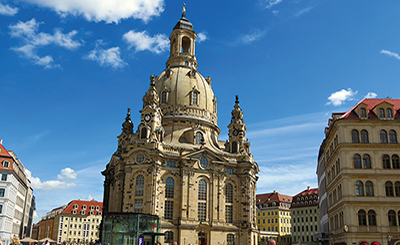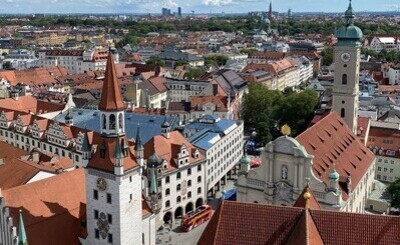
Frauenkirche (Church of Our Lady), originally built in the 18th century. Photo courtesy of the author
I had always wanted to travel to Dresden, a city I had over the years come to associate principally with the ravages of the Second World War. Finally, I arrived in Dresden in the summer of 2013, expecting to witness a wounded city standing amidst the ruins and remains of the World War. What my eyes beheld instead was a glorious city reincarnate, standing much like a monument to itself. Here I was, walking not through rubble and ruins, but across an endless carpet of summer-green dotted with tiny flowers in yellow and white. A brief Google search later in the day confirmed that I had indeed arrived in one of Europe’s greenest cities and a former World Heritage site.
Dresden, the capital city of the Free State of Saxony in Germany, is situated in a valley on the river Elbe, 62 miles south of Berlin. Dresden is a city of fairly recent origin. In the 18th and 19th centuries Augustus the Strong, the Elector of the Kingdom of Saxony and King of Poland, and his successors transformed Dresden into the ultimate capital of art and technology. Augustus the Strong particularly patronised the arts and architecture and is known for giving Dresden its first museum as early as the 18th century. His extraordinary collections of paintings and fine porcelain are on display in various museums in the city today. Most of the landmark monuments that make up Dresden’s historical centre today — like the Zwinger Palace, the Dresden Castle, the Catholic Court Church, and others — were commissioned by Augustus the Strong. It was not long before Dresden became one of Europe’s prime cultural destinations and came to be sometimes described as the “Florence on the Elbe”.
All of this magnificent past of Dresden, it’s grandiose palaces, churches, museums and opera houses, fell silent forever on the midnight of February 13, 1945 when British and American forces indulged in indiscriminate “carpet bombing” of the city in a bid to close in upon Hitler, the Führer (leader) of the Third Reich or Nazi Germany. Between 13 and 15 February 1945, 1,249 heavy bomber planes of the British Royal Air Force and of the United States Air Forces dropped more than 3,900 tons of high-explosive bombs and incendiary devices (fire bombs) that set off a firestorm with temperatures above 1,500 degree Celsius and rocketed smoke and ashes close to 15,000 feet into the sky. Considered “militarily unjustified” by most critics of the bombing the aerial attacks claimed the lives of nearly 25,000 civilians, reducing most to mere cinders within minutes. And within a few hours, the city’s historical centre remained transformed into a sea of rubble and ruins engulfed in smoke, fire, darkness and death — the only remains of a once powerful, rich and flourishing cultural capital.
Studies reveal that a whopping one and half million tons of bombs were dropped in aerial raids on German cities between 1942 and 1945 in what in warfare terminology is described as “area bombing” (as against “precision bombing”) that claimed the lives of an estimated 3.6 million civilians and 3.3 million soldiers. Notwithstanding this, by the end of the war, the Allied Forces had 11 million German soldiers in capture as Prisoners of War. Acknowledged as one of the most dreadful devastations in mankind’s war history, both, in terms of geographical extent as well as loss of life and property, the bombing of Dresden in many ways marked the beginning of the end of the Second World War in Europe that finally ended in May the same year, only days after Hitler’s suicide on 30 April, 1945 in his Führerbunker even as the Allied shelling razed Berlin and the enemy closed in upon him.
The thundering defeat of Germany’s Nazi Regime finally culminated in the formation of two German states — East Germany and West Germany; the former controlled by Soviet Russia and the latter by the United States. The impact of the Cold War between Soviet Russia and the United States peaked in Germany in the year 1961 in the form of the Berlin Wall that physically not only cut apart East and West Berlin but the whole of Germany and checked the inflow of refugees from a stagnant Communist East Germany to a more thriving Capitalist West Germany. In 1990, the collapse of Soviet Russia and the end of the Cold War resulted in the fall of the Berlin Wall and the reunion of East and West Germany.
Page
Donate Now
More from Culture
Comments
*Comments will be moderated
That was amazing. I never write comments on anything but I have to say that was beautiful. Thank you for giving us faith in humanity.
David Figueroa
Jul 19, 2023 at 01:02













